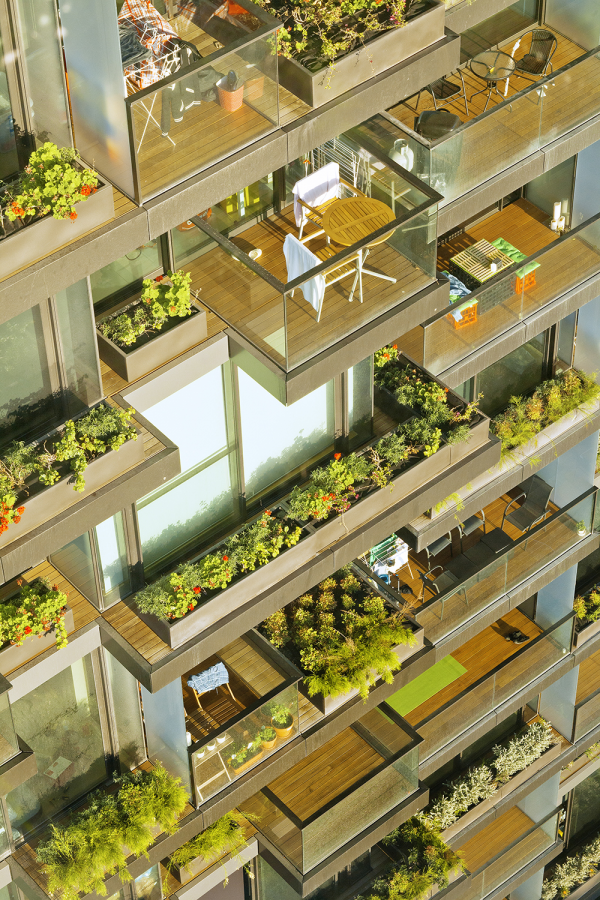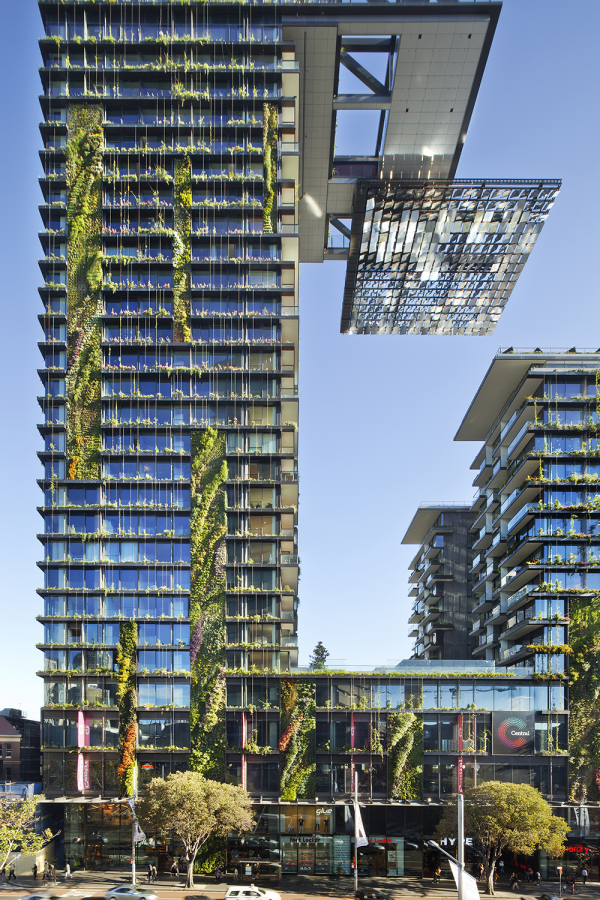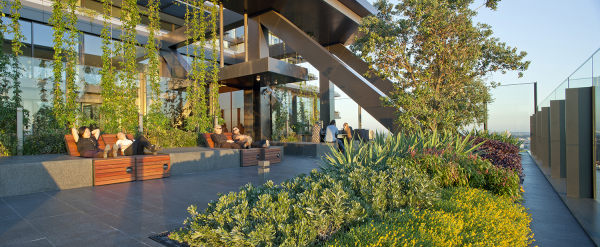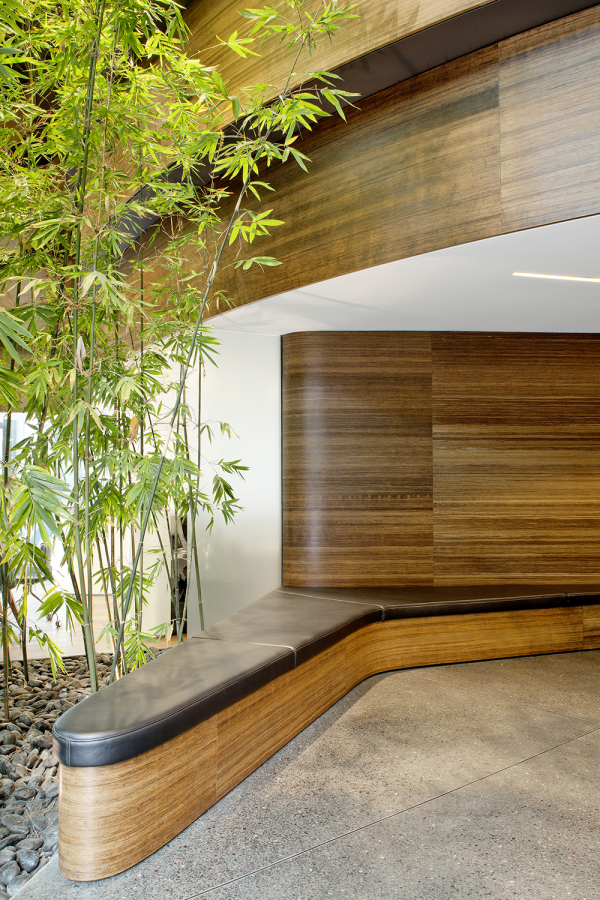









Image Credit : Simon Wood

Project Overview
One Central Park is an architectural collaboration between Ateliers Jean Nouvel and PTW Architects located in Sydney’s downtown. This high profile project on the former Carlton United Brewery site, is the first stage of the Central Park development. One Central Park comprises two residential towers and a lower retail podium addressing the site’s Broadway frontage. The built form is veiled by a combination of vertical gardens, designed by Patrick Blanc, as well as green facades for each residence, the planting for which has been developed and delivered by ASPECT | OCULUS.
ASPECT | OCULUS were engaged in early 2011 to develop the initial concept designs for the facades, as well the internal residential lobby, ground floor planting, podium garden, sunken courtyard and atrium planting for the retail levels.
One Central Park is the largest green facade in Australia with considerable microclimatic challenges. To ensure planting success, the planting design and technical development was tested through a rigorous process. A wind speed and sun/shade analysis was modelled to determine plant suitability for the facades, and light lux levels were recorded to determine hardiest planting for low level light in the lobby and atrium.
Project Commissioner
Project Creator
Team
Full Consultant Team
Design and Concept
Ateliers Jean Nouvel (Principal Architects for the building)
PTW Architects (Architects for the building)
Patrick Blanc (Botanist and designer of the Vertical Gardens)
JAAA +Turf Design Studio (Landscape architects for the master plan)
Design Development to Construction
ASPECT|OCULUS (Landscape architects for the design development and documentation of the The Green Facade and courtyards)
Patrick Blanc (Botanist and designer of The Vertical Gardens)
Junglefy (Installation of the Vertical Gardens)
Ateliers Jean Nouvel (Principal Architects for the building)
PTW Architects (Architects for the building)
Andreasens Green (Plant Supplier)
SESL (Soil Consultant)
Hydroplan (Irrigation Designers)
Watpac Construction (Builders)
Design Landscapes (Landscape & Irrigation Subcontractor)
Project Brief
The original master plan for Central Park was developed by Ateliers Jean Nouvel and Foster and Partners. This was further developed by the design team to create additional public open space and improve pedestrian links. The brief for One Central Park included a range of “green infrastructure” initiatives including green roofs, living facades, recycling demolished materials, adaptive re-use of buildings, sewer mining, water harvesting, tri gen, and car share. The initial concept by Atelier Jean Nouvel was for some of the green and varied neighbourhood character of adjacent Chippendale to ‘invade’ the site, extending through the central park and other public domain, to envelope the One Central Park building. This brief was expressed in the early architectural renders and further developed to include both a number of large vertical gardens by Patrick Blanc and façade planting at each level of the building.
Project Innovation/Need
One Central Park is the most ambitious ‘living architecture’ projects in Australia and has no precedent in this country. It is a combination of living walls and green facades (vines on supports with cascading plants). This is the first combination of these two systems in Australia. Water usage was a big issue as well as compliance to a 5 Green star rating. It was necessary to irrigate using reclaimed and treated sewerage (blackwater) from the building itself. This sort of automated irrigation system of this scale has not been implemented before. Any additional fertilising is carried out with ‘fertigation’ process with nutrients added to the irrigation, at a carefully monitored dosage. Nutrient and chemical imbalances can be corrected through this system. Maintenance of the green façade is an ongoing issue due to the heights and exposure. The soil requirements for the planterboxes needed to ensure that soil would has a long a life span as possible. The soil mix was specially developed for the project has similarities closer to hydroponics than conventional soil. The wind exposure and plant selections were tested in a wind tunnel to ensure suitability of the green wall system.
Design Challenge
The design challenges mainly revolved around successfully establishing the planting on the facades in the face of difficult and varied environmental challenges including exposure to sun and wind, water and nutrient requirements, plant support/stability and maintenance. These challenges were addressed by a range of innovative measures including new technology, technical development and testing. Product testing and research and development played a big part in the design. Planter box systems, living wall design, soils, irrigation, drainage, mulch layer and access for maintenance were all project specific and had to be trialled.
The developer Fraser Properties (and Sekisui House) took a development risk on the suitability for greening a building in being a marketing point of difference and creating a gateway building for the city, as well as achieving sustainability objectives. The success of One Central Park in all of these aspects is now becoming apparent.
Sustainability
Climate adaptation and urban greening is a fundamental issue challenging designers of the built form. One Central Park can inspire future urban projects to also use urban greening to create more environmentally and socially sustainable cities. The landscape design of One Central Park needed to be sustainable from an economics perspective, in the selection of durable materials and planting, the reuse of waste water for irrigation and ease of maintenance. Along with a range of other initiatives, these have helped the Central Park project become a benchmark in terms of the planning and design of a new urban precinct. We would hope that this project will drive the development of ‘living architecture’ and green urban infrastructure that exceeds its achievements even further in the future.
Landscape Design
This award celebrates creativity and innovation in the use of practical, aesthetic, horticultural, and environmental sustainability components, taking into account climate, site and orientation, site drainage and irrigation, human and vehicular access, furnishings and lighting.
More Details


